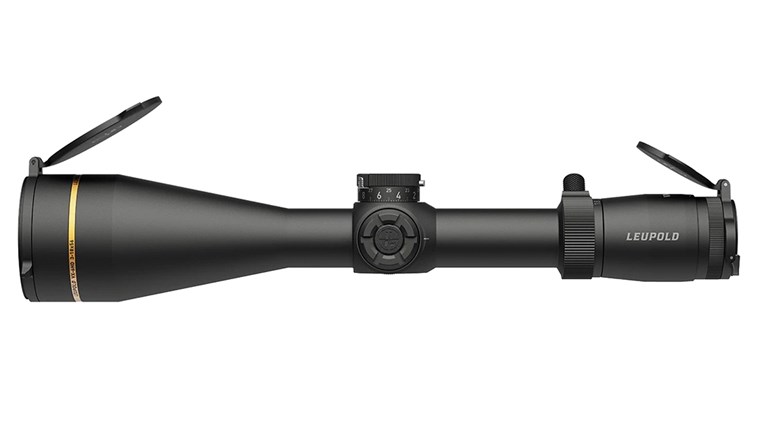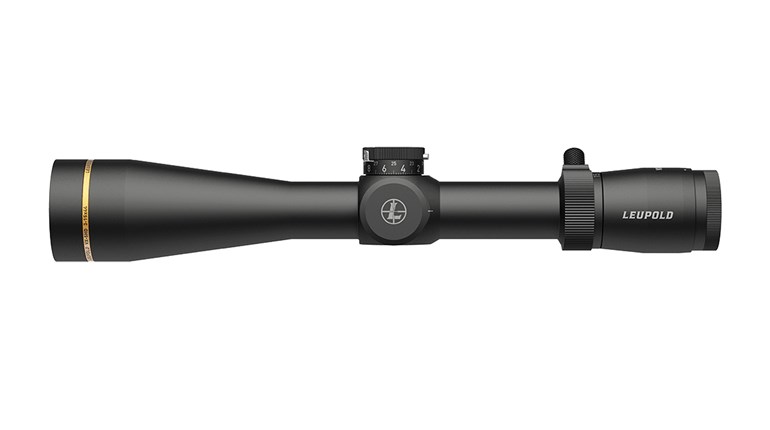
For the first 100 or so years of riflescope use, sharpshooters and snipers had to choose between fixed low-powered magnified optics and iron sights. Many amazing shots were recorded with those 1X to 4X scopes right through the Korean War. But as technology improved the quality of riflescopes, military snipers began fielding a variety of fixed- and variable-power optics with higher magnification.
With accurate cartridges like the .338 Lapua Mag. helping to push the envelope past the 1,500-meter mark, variable-magnification riflescopes in the 5-25X range are now moving to the forefront. While long-range effectiveness has increased, this trading up has cost our snipers several low-power benefits. These include increased field of view, better light transmission, smaller scope size and—most critical in a dynamic gunfight—the ability to rapidly engage close threats.

Two developments have highlighted this weakness in recent years. The first is the advent of mass-produced, semi-automatic sniper rifles that are both reliable and accurate. The second is the Global War on Terror. Today's snipers regularly need to clear or fight their way into and out of firing positions, where semi-autos come in handy. I was fortunate to have access to such rifles for all of my operational sniping work, even before Sept. 11. Lessons learned across the board have driven all services to adopt various forms and quantities of semi-automatic sniper rifles for overseas use.
While every sniper or designated marksman should eventually have a rifle or carbine capable of dealing with dynamic environments, that won't fix the riflescope dilemma. I spent several tours in Afghanistan switching between low- and high-powered optics for each mission, always hamstrung one way or the other in the process. In Operation Iraqi Freedom, I had high-quality 1-4X optics that allowed accurate shots from close quarters out to approximately 500 meters. However, both theaters presented distances requiring more power, which sacrificed the close-target capability. Once this near/far sniper optics shortcoming was identified by multiple military units, several scope manufacturers began working hard to find a remedy.

Options for dealing with both close threats requiring rapid engagement and long-range targets calling for precision fire, up to this point, have been limited. Awkwardly pairing a reflex sight with a full-power day scope, carrying a separate carbine or using a sidearm to deal with close targets are primitive solutions, at best.
When my final Army duties placed me in a weapons research and development capacity, the snipers I took care of identified the need for more power in a CQB-capable optic. It was my job to explain that need to the optics industry and convince it to push the envelope. I made some initial headway, but the fight was still uphill when I retired. Fortunately (for the good guys), I was succeeded by far more capable and articulate Soldiers who ensured this paradigm-shifting class of optics finally got to see daylight. That makes me smile.
The features our military snipers look for in a full-range optic aren't unique to wartime. Law enforcement snipers, 3-gun competitors and predator hunters will find much to like in these scopes. The key is for low-end magnification to be as close to zero as possible. Conversely, the high end needs to be no less than 8X, so shooters can take full advantage of their gun/cartridge combinations.
This criterion has been the biggest stumbling block, as a zoom factor of eight has been a sort of Holy Grail in the optics industry.

A first-focal-plane (1FP) reticle, which allows use of the requisite milliradian-based reticle's measurement and holdover features at any power, is also critical. Illumination can be important, but not mandatory—provided the non-illuminated reticle can be acquired quickly at low power and in all light conditions.
Elevation and windage knobs have the nasty habit of being turned off their zero settings through active maneuvering while wearing battle gear. Lockable turrets are a combat-proven solution to this problem. Other good features include fast-focus eyepieces, 30 mm or larger tubes and reticles that subtend less than 1 mil. Ideally, scope size shouldn't grow much more than current short-range scopes.
I've laid hands on several new scopes in this category and gave them a good workout on 5.56 NATO and .308 Win. platforms. Overall, I'm happy with what I saw in these prototypes and feel confident anyone with a need for this type of optic will have a good range of options from which to choose. Other manufacturers are working on solutions, so the field should soon widen appreciably when their designs are introduced.
The three riflescopes I tested for this article possess common features, such as 1FP reticles subtending below 1 mil, fast-focus eyepieces and a fixed-parallax setting. All have dedicated "off" positions between brightness settings on their rheostats. This feature allows the shooter to be one simple click away from the desired brightness level without burning battery time. Finally, each scope's windage and elevation knobs are graduated in .1-mil clicks. Moving the strike of the bullet 1 centimeter at 100 meters doesn't necessarily excite most folks on this side of the Atlantic. However, once you experience the convenience and accuracy of clicks that correspond precisely to the reticle values (10 clicks equal 1 mil) you'll understand why we now see this feature on many scopes.
Leupold 1.1-8x24 mm CQBSS

While passing through Leupold's booth at the SHOT Show in January, I noticed crowds gathering around several CQBSS scopes on display. The company's new optic is user-friendly, and its tactically appealing features were generating much buzz. For example, the zoom function is handled by the entire ocular bell. There's no need to apply gorilla strength to a small ring. You simply rotate the knurled eyepiece until you reach the desired magnification. One drawback with this setup is that flip-open caps will rotate as power is adjusted, possibly getting in the way of charging or bolt handles.
The scope's 34-mm main tube provides extra rigidity and generous elevation travel. Locking elevation and windage knobs are handled by a spring-loaded design. To adjust windage or elevation, simply squeeze each side of the appropriate knob and turn. Upon release, the spring-loaded half-moon tabs return to their locked positions. The verdict isn't in yet on this design's durability after hard use in the blowing sand, talc dust and mud-filled combat environments. If a knob were to get stuck, the good news is that reticle selections are perfectly suited for zeroing and then abandoning the knobs altogether for elevation and windage needs.
The very flexible, combat-proven Horus H27 reticle is standard and well adapted to modern sniping. Leupold's own Tactical Milling Reticle (TMR) should eventually be available in the CQBSS as well. These reticles allow advanced aiming via .2-mil markings (H27) and 1⁄2-mil markings (TMR) that extend far beyond the traditional 5 mils below center.
The CQBSS' internal adjustments matched its knob graduations perfectly, and I found the 5-MOA dot's brightness easy to acquire in any lighting condition. I had trouble seeing the prototype's dot when my eye wasn't perfectly centered, but Leupold says this problem has been remedied on production models.

From 5X to 8X, the H27 reticle in my test scope worked very well for precise aiming, and the heavy, main horizontal stadia lines served as a quick reference for rapid aiming at low power with the dot turned off.
Lastly, the diopter adjustment on the Leupold has a "jam nut" lock ring that holds it in the focused position. The CQBSS' quality is better than most U.S.-made riflescopes.
Leupold will also be offering several bullet-drop-compensating (BDC) rings for the CQBSS' elevation knobs for those shooters who prefer to dial in their dope. All in all, Leupold did its homework on the new CQBSS, and there is no doubt it has upped the ante on quality.

Premier Reticles V8 1.1-8x24 Tactical
Elements of Premier's Heritage Tactical 3-15x50 mm—the USMC's newest Scout Sniper day scope—can be seen in the V8 Tactical. The V8's form and function both reflect specifications asked for by our fighting troops with a few special touches thrown into the mix.
The most unique feature is a two-phase reticle-illumination system that allows use of either a 5-MOA dot placed in the second focal plane (2FP), or a 1FP fully illuminated reticle. When using the scope between 1.1X and 3X for close-quarters shots where speed is required, the 2FP flash dot remains constant in size regardless of power. Once beyond 3X, the dot disappears and illumination switches to the mil-based, Gen II CQB reticle. Thishollow-dot design is easy to see at all powers when illuminated, and its placement in the 1FP ensures reticle size remains relative to the changing target image when changing powers.
The transition between illumination systems is seamless, requiring no action beyond adjusting power up or down. The key benefits are that the center dot doesn't obscure the target at higher powers, and the illuminated mil dots make the reticle usable during transitional light (dusk and dawn) and when contrast is needed against a night-vision device's image.

The V8's locking knobs are Premier's standard design. Pulling them out allows turning against very positive .1-mil clicks. Pushing the knobs in locks the setting in place, and zeroing or "slipping" the graduated scales can be done without tools. The Gen II CQB reticle subtends to 1⁄2 mil and has at least 95 mils (327 MOA) available in 5-mil increments along the heavy stadia lines. Thus, the V8 provides shooters with the capability to use reticle holds for both windage and elevation.
The rheostat knob unlocks by pulling it out to rotate through "on" settings and locks in the down position. While my test sample had no rheostat clicks, Premier's production V8 scopes will lock in any "on" or "off" position, and all settings will have distinct clicks. The first three brightness settings are night-vision compatible, allowing illuminated use without washing out image-intensified night optics placed behind the scope.
The forward placement of the V8's saddle requires unusual mounting to get the eye relief set properly, but I found placing both rings on the same scope section to work well. Premier's optical quality is unusually good for U.S.-branded riflescopes, and the V8 is no exception. Overall I found the V8 to possess the same quality and solid features as Premier's other optics. I'd feel comfortable heading into harm's way with one atop my favorite .308 Win. carbine.

Horus Vision 1.5-8x24 mm BlackBird
Horus Vision's entry is somewhat of an odd-man-out in this category. As tested and currently available, the BlackBird is really a big scope in a little body. It's significantly smaller and lighter than the others I tested, but still delivers long-range performance. The newly designed H58 reticle provides a quick ranging and acquisition feature, as well as effective hold points for windage and moving targets. At 8X, longer-range targets are where the BlackBird really comes into its own.
The BlackBird's shortfall is that it's difficult to use for rapid target acquisition at low powers. The 1.5X low-end is slightly higher than desired for this type of optic and is further hampered by a dimly illuminated center crosshair area. Even at the brightest setting, it's very hard to see except in the darkest environments, which is a huge liability when mounted on a rifle intended for close-quarters battle. Horus is working to fix this problem, and the company told me it plans to replace the dim crosshair with a bright dot in the very near future.
Unfortunately, no help is provided by the non-illuminated portion of the reticle. Its long-range/high-power strength—a very thin reticle for precise aiming—is also its low-power Achilles heel. I found the reticle very difficult to pick up quickly between 1.5X and 3X.

Horus employs capped elevation and windage knobs instead of locking knobs. All Horus reticles eliminate the need to dial in elevation and windage. Once zeroed, the knobs are capped and left alone. I'm very comfortable with this aiming system. The rheostat's clicks are very positive, providing easy access to the desired brightness position. Although the zoom ring was too stiff for fast manipulation, I've found this component generally smooths out through use.
Optical quality on my test sample was very good, and each .1-mil click precisely moved the strike of my bullets downrange. Overall, I like the BlackBird as a minimally sized optic with long-range performance.
The introduction of riflescopes that allow long-range target engagement without sacrificing the ability to deal with close threats completes the sniper's triad. A few years back, a foreign optics company's chief engineer laughed at my full-range sniper-scope concept, calling me an idiot and saying it couldn't be done. While I can't argue with the first statement, I'm glad he was wrong on the second.





































